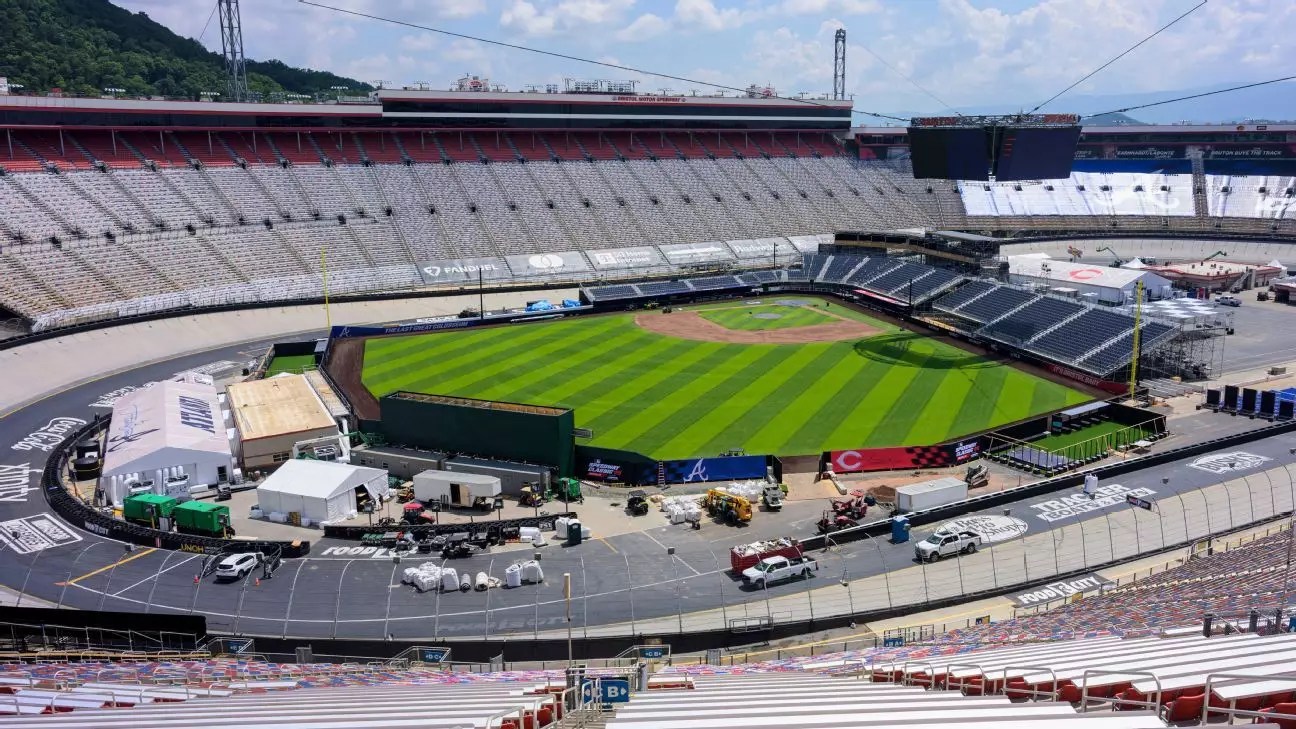Bristol Motor Speedway, known colloquially as the “Last Great Colosseum,” has long stood as a symbol of American sports enthusiasm. Traditionally celebrated for its roaring NASCAR races, the venue recently entered a new chapter, temporarily transforming into a formidable baseball stadium for the MLB Speedway Classic. This conversion wasn’t merely about swapping out racing equipment for baseball facilities; it was a testament to the venue’s remarkable versatility and the commitment of organizers to push boundaries. The event drew an impressive record crowd of over 91,000 spectators, establishing that Bristol’s appeal extends beyond its traditional motorsport roots. Yet, such grandeur came with a formidable challenge—the logistical and structural overhaul required to revert the infield back to its racing configuration.
The process speaks volumes about the innovative mindset at play. Major League Baseball’s deployment of sophisticated tools like BaAM (Baseball Analytics and Management) allowed for rapid construction of essential facilities—clubhouses, batting cages, and broadcast booths—mirroring the infrastructure found in professional stadiums. This scale of rapid transformation underscores an impressive synergy between sports disciplines, where technology and planning converge to make seemingly impossible transitions feasible. For Bristol, these efforts transcend mere logistics; they symbolize a broader cultural adaptability, signaling that venues of historical significance can serve multiple purposes without losing their identity or functionality.
Engineering Marvels and Environmental Consciousness in Renovation Efforts
The technical artistry behind the infield transformation is equally compelling. Leveling the terrain with 17,500 tons of gravel and overlaying it with 340 tons of Pennsylvania clay exemplified meticulous planning. Every detail—pouring concrete, ensuring proper curing time, and rebuilding pit walls—was executed with precision, highlighting the complexity of temporarily converting a high-profile racing track into a baseball diamond. One can appreciate that such alterations do not happen overnight; they require a delicate balance of speed and patience, ensuring safety and quality are never compromised.
Interestingly, this transformation also reflects a conscious effort toward environmental responsibility. Swift’s mention of repurposing gravel for Bristol’s parking lots and utilizing remnants of plywood and 2x4s for community rebuilding demonstrates a commendable approach to sustainability. In the face of natural disasters, such as Hurricane Helene, Bristol’s management recognizes the importance of channeling resources back into the community, turning what could be waste into vital rebuilding materials. This approach elevates the event beyond mere spectacle; it positions the venue as a proactive community partner contributing to resilience and sustainability, which in turn enhances its reputation as a responsible and innovative sports hub.
Balancing Disruption With Strategic Foresight
The rapid turnaround from baseball to NASCAR was not merely a logistical feat but also an exercise in strategic foresight. Swift and his team set an ambitious target of completing the reconfiguration by September 7—a timeline demanding relentless coordination among construction crews, event organizers, and NASCAR teams. The process involved disassembly of the temporary structures, re-surfacing the infield with asphalt, and installing the necessary racing infrastructure—all within a narrow window.
What stands out is the preparedness for contingencies. Recognizing that some finishing touches, like paint drying, might extend beyond the deadline, planning was resilient enough to accommodate minor delays. This flexibility underpins the confidence in the project’s overall success and exemplifies best practices in large-scale event planning. More notably, Bristol’s capacity to handle such complex transformations hints at an evolving blueprint—one that hosts multiple sports and events, proving that a venue designed for speed can also excel in baseball, football, and potentially even hockey.
Beyond the Present: A Beacon for Multi-Sport Innovation
The narrative of Bristol Motor Speedway isn’t solely about its engineering or logistical prowess; it’s about redefining what a sports venue can be. Historically rooted in NASCAR, Bristol is now emerging as a versatile stage capable of hosting diverse high-profile events—from college football games to potential NHL showcase matches. The fact that the NHL is evaluating Bristol as a future venue signals an exciting evolution, positioning the racetrack as a multi-sport nexus.
This adaptability challenges conventional notions that sports venues must be specialized and static. Instead, Bristol exemplifies a dynamic approach—where infrastructure, technology, and strategic planning converge to foster innovation. Such versatility not only boosts the venue’s economic resilience but also cements its place as a cultural landmark capable of adapting to the shifting landscape of sports entertainment.
While critics might warn of overextension or logistical wear, the boldness of these endeavors suggests that Bristol is pioneering a new era—a model for venues worldwide on how to blend tradition with modernity, all while maintaining the capacity to deliver unforgettable experiences across multiple disciplines.

